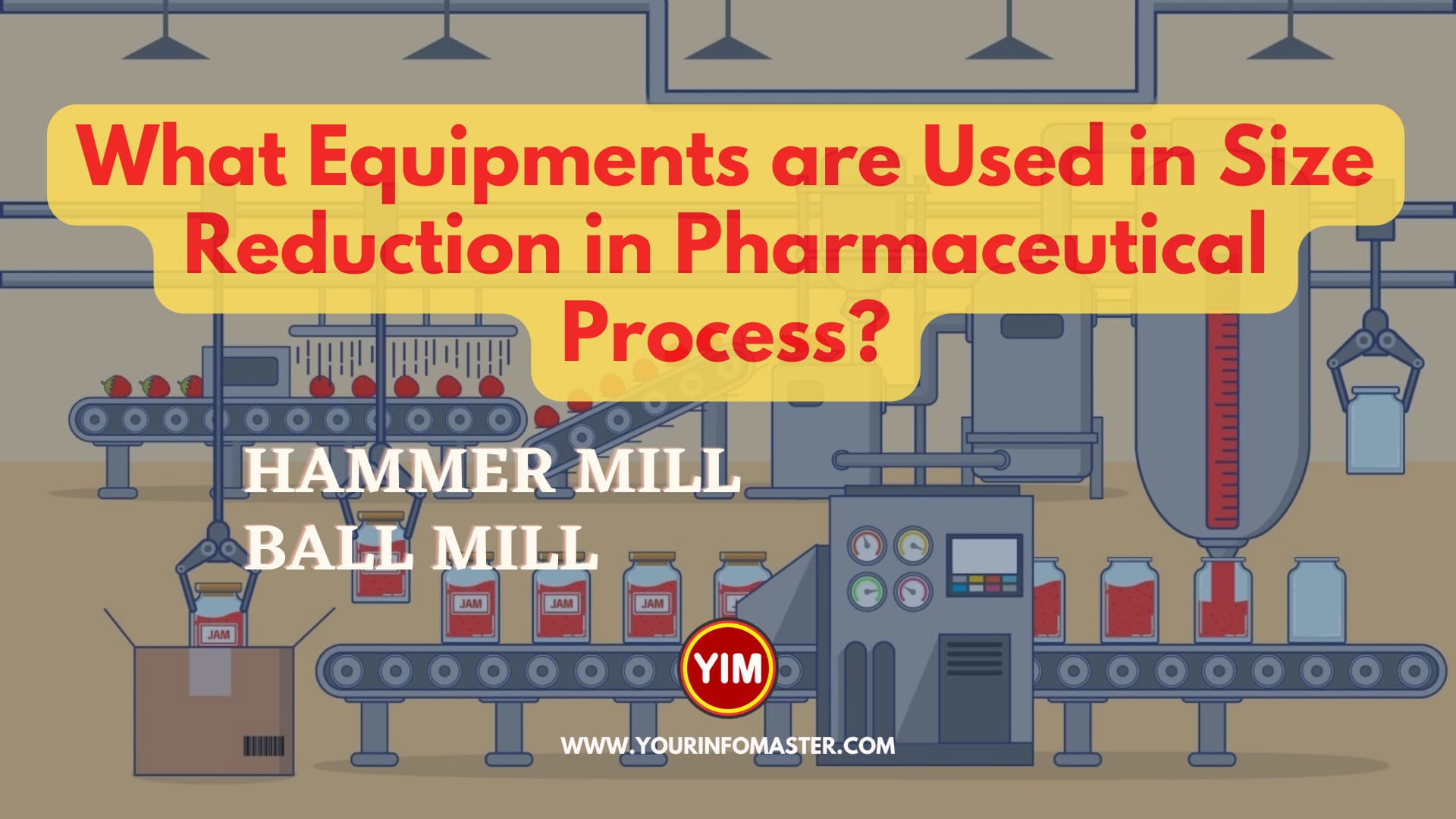Size Reduction Equipments: Size reduction is an important part of making medicines because it makes it possible to make particles that are all the same size. This is important to make sure that the drug dissolves and is absorbed well and that the final product looks good and is easy to handle.
A variety of equipment is used in size reduction, including comminuting mills, granulators, pulverizers, crushers, coarse and fine grinders, Fitzmills, Fluid Energy Mills, High-Pressure Homogenizers, Colloid Mills, Media Mills, Mixers, Blenders, Agitator Bead Mills, and Ultrasonic processors.
Each type of equipment has its own unique characteristics and is suitable for different types of materials and applications. They are used to reduce the size of powders, granules and other solid materials to make them more suitable for the intended use.
ALSO READ: General Guidelines of Compounding and Dispensing in Pharmaceutics
Size Reduction Equipments list
Size reduction equipment used in the pharmaceutical industry includes:
- Comminuting mills (such as hammer mills, roller mills, and ball mills)
- Granulators (such as cutting granulators, oscillating granulators, and low-shear granulators)
- Pulverizers (such as jet mills and cryogenic grinders)
- Crushers (such as jaw crushers, cone crushers, and impact crushers)
- Coarse and fine grinders
- Fitzmills
- Fluid Energy Mills
- High-Pressure Homogenizers
- Colloid Mills
- Media Mills
- Mixers
- Blenders
- Agitator Bead Mills
- Ultrasonic processors.
Structure, functions and importance of Hammer Mills in Pharmaceutical Industry
A hammer mill is a type of size reduction equipment that is used in the pharmaceutical industry for the reduction of particles. The basic structure of a hammer mill consists of a horizontal rotor assembly equipped with several hammers, which rotate at high speeds inside a cylindrical chamber. The hammers are made of hardened steel and are designed to impact and break down the particles as they pass through the mill.
The function of a hammer mill is to reduce the size of particles by means of mechanical impact. The hammers collide with the particles, causing them to break down into smaller sizes. The size of the particles is determined by the size of the openings in the screen that surrounds the rotor. The screen can be changed to adjust the particle size.
The importance of hammer mills in the pharmaceutical industry lies in their ability to produce consistent particle sizes for specific applications. This is crucial for achieving optimal drug dissolution and absorption, as well as for ensuring that the final product is visually pleasing and easy to handle. Additionally, hammer mills are versatile and can be used to grind a wide range of materials, including powders, granules, and other solid materials. They are also efficient and can be used to process large volumes of materials in a short amount of time.
Moreover, hammer mills are relatively easy to operate, maintain and clean, they are also relatively inexpensive compared to other types of size reduction equipment. The hammer mills are suitable for both dry and wet materials, making them versatile for a wide range of applications in the pharmaceutical industry.
Structure, functions and importance of Ball Mills in Pharmaceutical Industry
A ball mill, also known as a jar mill, is a type of size reduction equipment that is used in the pharmaceutical industry for the reduction of particles. A ball mill’s basic design consists of a cylindrical container (jar) filled with a specific number of balls (usually made of steel or ceramic). The jar is put on an axis that runs horizontally and is then turned at a certain speed.
The function of a ball mill is to reduce the size of particles by means of mechanical impact and attrition. The balls inside the jar collide with the particles, causing them to break down into smaller sizes. The size of the particles is determined by the size of the balls and the speed of the rotation of the jar. The rotation speed can be adjusted to achieve the desired particle size.
The importance of ball mills in the pharmaceutical industry lies in their ability to grind materials to very fine particle sizes. This is crucial for achieving optimal drug dissolution and absorption, as well as for ensuring that the final product is visually pleasing and easy to handle. Additionally, ball mills are versatile and can be used to grind a wide range of materials, including powders, granules, and other solid materials. They are also efficient and can be used to process large volumes of materials in a short amount of time.
Moreover, ball mills are relatively easy to operate, maintain, and clean. They are also relatively inexpensive compared to other types of size reduction equipment. Ball mills can be used for both dry and wet grinding, which makes them versatile for a wide range of applications in the pharmaceutical industry. They are also available in different designs, including bench-top, laboratory, and industrial-scale models.
CONCLUSION
Size reduction equipment is an essential part of the pharmaceutical manufacturing process. It allows for the creation of consistent and uniform particle sizes, which is crucial for optimal drug dissolution and absorption.
Each type of equipment is suitable for different types of materials and applications.
If you enjoyed “Size Reduction Equipments,” I’d be very thankful if you’d help it spread by emailing it to your friends or sharing it on Twitter, Instagram, or Facebook. Thank you!
Did you read Packaging of Pharmaceutical Products on the way? Which one do you read? Let us know if you have any questions. We will gladly explain!
Related Topics: If you really enjoy size reduction equipments in pharmaceutical processes, then there are some more interesting articles for you!
- What Equipments are Used in Mixing Pharmaceutical Process?
- Define Drug and Explain Classification of Drugs?
- Define Pharmaceutics, Pharmacist, Pharmacy Technician and Explain Responsibilities of Pharmacy Technician
- General Guidelines of Compounding and Dispensing in Pharmaceutics
- What is Pharmacognosy and Scope of Pharmacognosy?







